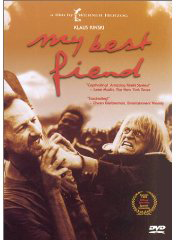 Against my better judgment, I am becoming a real Werner Herzog fan. Even though I find his megalomania and world view repulsive, there’s something deeply human and irresistible about his films. There’s an authenticity you don’t often find in filmmakers, a transcendent realness and willingness to invite you to share his thoughts. And I love that he makes films about the things that matter to him: in this case, Klaus Kinski, a German actor with whom Herzog made 5 films.
Against my better judgment, I am becoming a real Werner Herzog fan. Even though I find his megalomania and world view repulsive, there’s something deeply human and irresistible about his films. There’s an authenticity you don’t often find in filmmakers, a transcendent realness and willingness to invite you to share his thoughts. And I love that he makes films about the things that matter to him: in this case, Klaus Kinski, a German actor with whom Herzog made 5 films.
Synopsis: My Best Fiend is filmmaker Werner Herzog’s 1999 homage to actor Klaus Kinski who died in 1991. Herzog returns to the location of some of the films Kinski and he worked on together, and interviews actors and other people who worked with Kinski to paint a picture of a tortured genius. The film makes frequent use of clips from the films they worked on together, and details the frequent outbursts that colored their tumultuous working relationship.
Story Structure: The film is structured as a non-linear personal journey, in which Herzog makes use of archival footage, previous films, still photos and interviews to paint a portrait of Kinski in relationship with himself. In fact, the film doesn’t really tell us anything about Kinski beyond his relationship with Herzog, to the point where this film could be said to say more about Herzog than it does Kinski. Herzog and Kinski, it seems, were made for each other.
Cinematography: Straightforward style shot by single camera operator, Herzog’s dp, Peter Zeitlinger. Lots of shoulder mounted following shots during interviews, everything appearing to be naturally lit. The more memorable clips in the film cinematographically were pulls from the films Aguirre, the Wrath of God, and Fitzcarraldo.
Editing: Lots of long sequences cut together simply by Herzog’s editor, Joe Bini, who uses an unobtrusive, simple cutting style to link the interviews by showing supporting film clips while Herzog’s voiceover narration carries the story. I particularly like the choice of opening – a long sequence in which Kinski is playing Jesus, and you seriously don’t know whether he’s crazy and should be handcuffed by police, or applauded for his performance. It’s also disconcerting that there are no subtitles, so you don’t even know what is going on, which of course is the point.
Music and Audio: Herzog makes frequent use of chanting vocals, and my favorite place where he does that in this film is the Machu Pichu scenes, in which he’s describing the filming on Aguirre. Interviews are recorded with visible lav mics. And in an interesting and unusual twist for Herzog, what appear to be actors are used opposite his narration to translate what the other characters are saying in many scenes. This was a little awkward and hard to follow at first, but once I figured out what was going on, it worked.
I learned a lot more Herzog trivia from watching this film: did you know, for example, that one of the crewmembers working on Fitzcaraldo saved his life by sawing off his foot with a chainsaw? He had been bitten by a deadly poisonous snake, and after realizing he would be dead very soon, he sawed off his leg, thus saving his life.
Hey there just wanted to give you a quick heads up. The words in your content seem to be running off the screen in Ie. I’m not sure if this is a formatting issue or something to do with web browser compatibility but I figured I’d post to let you know. The layout look great though! Hope you get the problem fixed soon. Cheers
Thanks Chuck. I’m replacing the server that this site is running on because of some major issues we’re having – that should take care of it by middle of next week. Sorry for the hiccup.